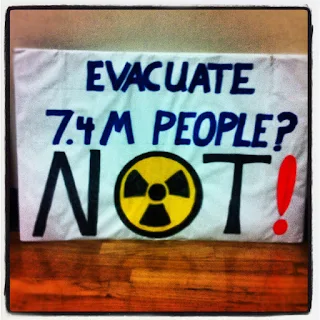Bags, Tape, Broomsticks, San Onofre & Repair, words you don't want to hear in the same sentence.
From Tonights 5pm @10News.
 |
| Fukushima USA |
So Cal Edison is now burying 136 Chernobyl's of radioactive waste 100 feet from the ocean in thin cans. #SaveTrestles
 |
| Fukushima USA |
 Goat Herder, Chicken Therapist, Victory Gardener, Food Forrester, Permaculturist, Small Engine Mechanic, Music Lover, Newbie Redneck, Former Nerd #RHEC
Goat Herder, Chicken Therapist, Victory Gardener, Food Forrester, Permaculturist, Small Engine Mechanic, Music Lover, Newbie Redneck, Former Nerd #RHEC
A seaweed clump lying directly in front of San Onofre Nuke has a high reading.
The clumps of seaweeds in front of SCE San Onofre registered between 0.18 and 0.38 microsieverts, in the same range as those I measured on the shore of south Fukushima prefecture. The Catalina readngs of 0.12 to 0.18 microsieverts in seaweed and 0.28 in barnacles and 0.20 limpets is higher than my findings at the Abukuma River basin near the border of Fukushima and Miyagi prefectures. (Note: By comparison, readings taken on the Japanese coast just south of the Fukushima No.2 plant were extremely high, often more than 1.2 microsieverts per hour.)By Yoichi Shimatsu Exclusive to Rense.com 4-23-13 read more of this sobering story.
|
 Goat Herder, Chicken Therapist, Victory Gardener, Food Forrester, Permaculturist, Small Engine Mechanic, Music Lover, Newbie Redneck, Former Nerd #RHEC
Goat Herder, Chicken Therapist, Victory Gardener, Food Forrester, Permaculturist, Small Engine Mechanic, Music Lover, Newbie Redneck, Former Nerd #RHEC
 |
| San Onofre Fukushima USA |
 Goat Herder, Chicken Therapist, Victory Gardener, Food Forrester, Permaculturist, Small Engine Mechanic, Music Lover, Newbie Redneck, Former Nerd #RHEC
Goat Herder, Chicken Therapist, Victory Gardener, Food Forrester, Permaculturist, Small Engine Mechanic, Music Lover, Newbie Redneck, Former Nerd #RHEC
 |
| Don't Let San Clemente California Become Fukushima USA |
 Goat Herder, Chicken Therapist, Victory Gardener, Food Forrester, Permaculturist, Small Engine Mechanic, Music Lover, Newbie Redneck, Former Nerd #RHEC
Goat Herder, Chicken Therapist, Victory Gardener, Food Forrester, Permaculturist, Small Engine Mechanic, Music Lover, Newbie Redneck, Former Nerd #RHEC
 |
| San Clemente Ocean Festival |
 Goat Herder, Chicken Therapist, Victory Gardener, Food Forrester, Permaculturist, Small Engine Mechanic, Music Lover, Newbie Redneck, Former Nerd #RHEC
Goat Herder, Chicken Therapist, Victory Gardener, Food Forrester, Permaculturist, Small Engine Mechanic, Music Lover, Newbie Redneck, Former Nerd #RHEC
 |
| Just Say No Fukushima USA |
 Goat Herder, Chicken Therapist, Victory Gardener, Food Forrester, Permaculturist, Small Engine Mechanic, Music Lover, Newbie Redneck, Former Nerd #RHEC
Goat Herder, Chicken Therapist, Victory Gardener, Food Forrester, Permaculturist, Small Engine Mechanic, Music Lover, Newbie Redneck, Former Nerd #RHEC
 |
| San Onofre Evacuation Zone |
 Goat Herder, Chicken Therapist, Victory Gardener, Food Forrester, Permaculturist, Small Engine Mechanic, Music Lover, Newbie Redneck, Former Nerd #RHEC
Goat Herder, Chicken Therapist, Victory Gardener, Food Forrester, Permaculturist, Small Engine Mechanic, Music Lover, Newbie Redneck, Former Nerd #RHEC
 Goat Herder, Chicken Therapist, Victory Gardener, Food Forrester, Permaculturist, Small Engine Mechanic, Music Lover, Newbie Redneck, Former Nerd #RHEC
Goat Herder, Chicken Therapist, Victory Gardener, Food Forrester, Permaculturist, Small Engine Mechanic, Music Lover, Newbie Redneck, Former Nerd #RHEC
 Goat Herder, Chicken Therapist, Victory Gardener, Food Forrester, Permaculturist, Small Engine Mechanic, Music Lover, Newbie Redneck, Former Nerd #RHEC
Goat Herder, Chicken Therapist, Victory Gardener, Food Forrester, Permaculturist, Small Engine Mechanic, Music Lover, Newbie Redneck, Former Nerd #RHEC
 |
| No Escape From San Onofre Meltdown. |
 Goat Herder, Chicken Therapist, Victory Gardener, Food Forrester, Permaculturist, Small Engine Mechanic, Music Lover, Newbie Redneck, Former Nerd #RHEC
Goat Herder, Chicken Therapist, Victory Gardener, Food Forrester, Permaculturist, Small Engine Mechanic, Music Lover, Newbie Redneck, Former Nerd #RHEC
 |
| San Clemente California ~ Fukushima USA |
 Goat Herder, Chicken Therapist, Victory Gardener, Food Forrester, Permaculturist, Small Engine Mechanic, Music Lover, Newbie Redneck, Former Nerd #RHEC
Goat Herder, Chicken Therapist, Victory Gardener, Food Forrester, Permaculturist, Small Engine Mechanic, Music Lover, Newbie Redneck, Former Nerd #RHEC
 |
| What part of Fukushima do you not understand? |
 Goat Herder, Chicken Therapist, Victory Gardener, Food Forrester, Permaculturist, Small Engine Mechanic, Music Lover, Newbie Redneck, Former Nerd #RHEC
Goat Herder, Chicken Therapist, Victory Gardener, Food Forrester, Permaculturist, Small Engine Mechanic, Music Lover, Newbie Redneck, Former Nerd #RHEC
 What
will be the fate of Southern California if this act of Nuclear Terrorism by the NUCLEAR MAFIA is allowed this experimental
restart at San Onofre Nuke plant?
What
will be the fate of Southern California if this act of Nuclear Terrorism by the NUCLEAR MAFIA is allowed this experimental
restart at San Onofre Nuke plant?